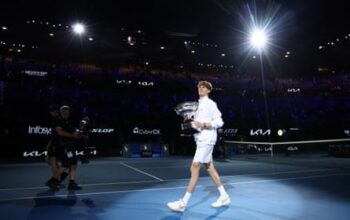Dino Prizmic was standing at the entrance of Rod Laver Arena, preparing for his first grand slam match. He couldn’t help but feel overwhelmed by the significance of the moment. Standing directly behind him was Novak Djokovic, adding to the pressure. As they both looked ahead, they could see a row of boards displaying the names and winning years of past Australian Open champions. Djokovic’s board had an impressive 10 different years listed.
The Croatian teenager faced the greatest player of all time with courage and determination, pushing Djokovic to push himself harder to come out on top. After a challenging four-hour match, Djokovic, in his longest first-round match in 14 years, moved on to the second round with a 6-2, 6-7 (5), 6-3, 6-4 victory.
In the beginning of the match, Djokovic showed no signs of struggle as he was focused on asserting himself and putting pressure on his opponent. He took more risks than usual with his forehand, aiming for the lines instead of his usual safer shots. This aggressive approach paid off as he easily won the first set.
At just 18 years old, Prizmic’s talent has been well known for some time and last year the Croat rose to become the French Open boys’ champion. As the first set quickly moved away from him, he did not panic. Despite calling the trainer multiple times in the second set to attend to an ailment to his right thigh, Prizmic gave a comprehensive demonstration of his talents until the end.
He displayed impressive movement on the court, smoothly shifting from side to side and retrieving numerous shots with ease. He also kept up with Djokovic’s physicality and emerged as the winner in many challenging and prolonged rallies. Prizmic’s powerful forehand repeatedly penetrated Djokovic’s defenses. He complemented his strong shots with consistent serving, a mature level of patience, and a willingness to end points at the net.
Prizmic’s strong performance caused Djokovic to make several unusual mistakes, especially during the second set tiebreak. Despite the intense competition, Prizmic managed to stay composed and even the score. He maintained his pressure on Djokovic in the third set and ultimately managed to break his serve, taking a 3-2 lead.
As Djokovic appeared to be in trouble, he managed to elevate his performance. He excelled in returning serves, enabling him to quickly regain the break and serve effectively during crucial points. Despite being behind, Djokovic won eight consecutive games and took a commanding 4-0 lead in the fourth set.
However, Prizmic persisted until the very end. He was able to regain one of Djokovic’s breaks and even managed to overcome being down triple match point while serving at 3-5. Djokovic was forced to secure the win with a strong service game. After the match, they embraced at the net and Djokovic praised his younger opponent. As the enthusiastic crowd cheered for the winner, Djokovic gestured for them to also acknowledge and applaud Prizmic as he left Rod Laver Arena.

Djokovic had an interesting beginning. He had already faced challenges with a wrist injury and was beaten by Alex de Minaur. However, Djokovic had stated before the tournament that he was feeling fine and played without showing any signs of discomfort.
Following another impressive season from Djokovic, the main inquiry regarding the men’s competition is whether any player is capable of defeating him at the pivotal tournament of his career. While the other players may find solace in witnessing Djokovic’s struggles, he has consistently found a way to overcome them. Throughout his career, challenging matches have only served to make him stronger. As he aims for his 11th Australian Open title, Djokovic will face the victor of the all-Australian first-round match between Alexei Popyrin and Marc Polmans, taking place on Monday.
Despite the day session of the stadium ending at 4:25pm, Djokovic did not leave the playing arena until around 11:30pm due to the two and a half hours between sessions. Tennis Australia’s decision to start the Australian Open on a Sunday was in hopes of avoiding late-night finishes. However, only an impressive performance from Aryna Sabalenka resulted in a reasonable finishing time on the first day as she easily defeated German qualifier Ella Seidel 6-0, 6-1 to advance.
It has been six years since Caroline Wozniacki won her first grand slam title at the 2018 Australian Open. Four years later, she retired at the 2020 Australian Open but has now made a comeback and reached the second round. In her match against Magda Linette, who was seeded 20th and was a semi-finalist last year, Wozniacki was leading 6-2, 2-0 when Linette retired due to injury.
“I entered this tournament with a clear understanding of my current position, my goals, and areas for improvement. It’s a slightly different situation, but I also feel that I have nothing to lose and everything to gain,” remarked Wozniacki.
This year’s women’s tournament features several players making comebacks, but not all of them are due to recovering from injuries or returning from maternity leave. Amanda Anisimova, who made it to the semi-finals of the 2019 French Open at just 17 years old, took a hiatus from tennis in April of last year to focus on her mental health. After nine months, the 22-year-old returned to the grand slam stage and won her match against the 13th seed, Liudmila Samsonova, with a score of 6-3 6-4.


